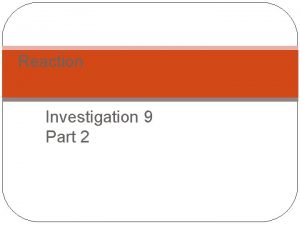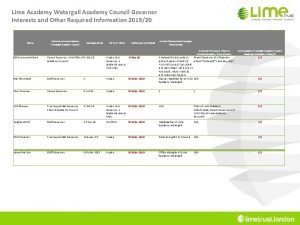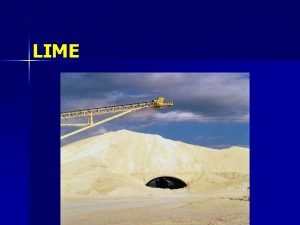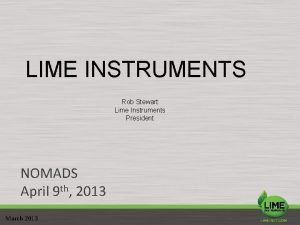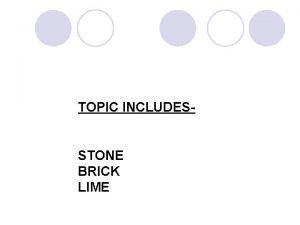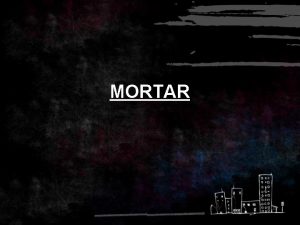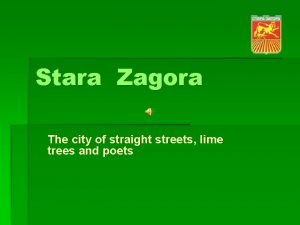TYPES OF MORTAR TYPES OF MORTAR Lime Mortar













- Slides: 13

TYPES OF MORTAR

TYPES OF MORTAR • • • Lime Mortar Lime – Surkhi Mortar Mud Mortar Cement Mortar Puzzolana mortar

FUNCTION OF SAND SURKHI IN MORTARS Functions of sand: • It reduces shrinkage of the building material. • It prevents development of cracks in the mortar on drying. • It helps in making mortars and concretes of desired strength by varying its proportions with the binding material. • A well graded sand adds to the density of mortars and concretes. Functions of surkhi: • It provides brick color and make the mortar economical

LIME MORTAR: • Lime mortar is a type of mortar composed of lime and an aggregate such as sand, mixed with water. • Lime mortar is primarily used in the conservation of buildings originally built using lime mortar, but may be used as an alternative to ordinary portland cement.

Limemortar • The paste is prepared by mixing lime and sand or surkhi in suitable proportions in addition to water. • If surkhi is to be added in lime mortar the equal proportions of sand surkhi should be mixed with lime. • These mortars are inferior to cement mortars in strength as well as water tightness. • These mortars should not be used for underground works as they set in the presence of carbon dioxide and break up in damp conditions. • This type is used for construction work above ground level i. e. exposed positions.

Mud mortar: • The paste is prepared by mixing suitable clay, soil with water. • The soil which is used for preparing mud mortar should be free from grass, pebbles etc. • These are the cheapest mortars but weakest in strength. • These mortars are used for brickwork of ordinary buildings and for plastering walls in rural areas.

Cement mortar: • The paste is prepared by mixing cement and sand in suitable proportions in addition to water. • The general proportion is 1 part of cement to 2 -8 parts clean sand. • These mortars must be use within half an hour, i. e. ; before initial setting time of the cement. • This type is used for all engineering works where high strength is desired such as load bearing walls, deep foundations, flooring etc.

• When mixing by hand, the sands and cement are heaped up on a mixing board or in a wheel barrow and repeatedly turned over and over until thoroughly mixed. • The color of the dry mix will change as the cement is distributed throughout - there should be no 'streaking' of cement, and no clumps of pure sand or pure cement. • Once the dry ingredients are mixed, the water can be added.

• When using a mechanical mixer, add half a bucket (2 or 3 liters) of clean cold water to the empty drum before adding the dry ingredients in sequence. • Add 4 measures of sand then 1 of cement, followed by 4 sand, then another cement and so on until the required quantity is in the mixer. • This ensures a more thorough mix than adding, say, 20 measures of sand then 5 measures of cement. • Again, the water is added to the revolving drum once the dry ingredients are thoroughly blended, a bit at a time until the required consistency is achieved.

For wide joints in paving or for stonework, either as paving or as walling, a coarser mortar is often preferred - replace half of the building/soft sand with grit/sharp sand. Youwill probably find that a coarse mortar such as this requires less gauging water to achieve a working consistency than does a bricklaying/general purpose mortar. Mortar for Wide Joints 2 x Building Sand plus 2 x Grit Sand plus 1 x cement

SPECIAL MORTARS �Fire – Resistant Mortar �Lightweight Mortar �Packing Mortar �Sound Absorbing Mortar �X-Ray Shielding mortar

Fire resistant mortar: • The paste is prepared by mixing aluminous cement and finely crushed fire bricks (1: 2) in suitable proportions in addition to water. • The usual proportion are 1 part aluminous cement to 2 parts of finely crushed fire bricks. • These are generally used for lining furnaces, ovens and fire places with fire bricks.

Light weight mortar: • The paste is prepared by mixing wood powder, wood sawing or saw dust with cement or lime mortar. • In such mortars fibers of jute coir or asbestos fibers can also be used. • These are generally used as fiber plasters in sound and heat proof construction.
 Differentiate between fat lime and hydraulic lime
Differentiate between fat lime and hydraulic lime Caustic embrittlement
Caustic embrittlement Discuss how permanent hardness of water can be removed
Discuss how permanent hardness of water can be removed Lime water milky
Lime water milky Lime water formula
Lime water formula Flitpit
Flitpit Magic lime academy
Magic lime academy Lime renters insurance
Lime renters insurance Lime furnishes the plant food element
Lime furnishes the plant food element Ferrox test
Ferrox test Metaphor in the fish poem
Metaphor in the fish poem Moodle bme
Moodle bme Co2 and lime water equation
Co2 and lime water equation 178 questions qcm aipr
178 questions qcm aipr




